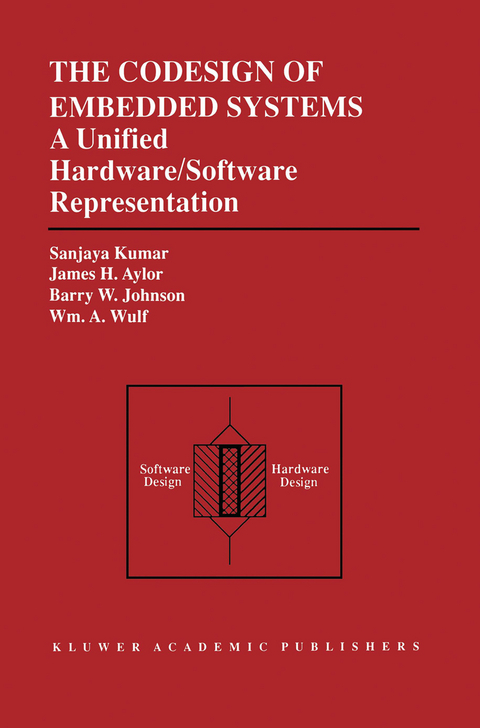
The Codesign of Embedded Systems: A Unified Hardware/Software Representation
Springer-Verlag New York Inc.
978-1-4612-8553-3 (ISBN)
Current practice dictates the separation of the hardware and software development paths early in the design cycle. These paths remain independent with very little interaction occurring between them until system integration. In particular, hardware is often specified without fully appreciating the computational requirements of the software. Also, software development does not influence hardware development and does not track changes made during the hardware design phase. Thus, the ability to explore hardware/software tradeoffs is restricted, such as the movement of functionality from the software domain to the hardware domain (and vice-versa) or the modification of the hardware/software interface. As a result, problems that are encountered during system integration may require modification of the software and/or hardware, resulting in potentially significant cost increases and schedule overruns.
To address the problems described above, a cooperative design approach, one that utilizes a unified view of hardware and software, is described. This approach is called hardware/software codesign. The Codesign of Embedded Systems develops several fundamental hardware/software codesign concepts and a methodology that supports them. A unified representation, referred to as a decomposition graph, is presented which can be used to describe hardware or software using either functional abstractions or data abstractions. Using a unified representation based on functional abstractions, an abstract hardware/software model has been implemented in a common simulation environment called ADEPT (Advanced Design Environment Prototyping Tool). This model permits early hardware/software evaluation and tradeoff exploration. Techniques have been developed which support the identification of software bottlenecks and the evaluation of design alternatives with respect to multiple metrics. The application of the model is demonstrated on severalexamples. A unified representation based on data abstractions is also explored. This work leads to investigations regarding the application of object-oriented techniques to hardware design.
The Codesign of Embedded Systems: A Unified Hardware/Software Representation describes a novel approach to a topic of immense importance to CAD researchers and designers alike.
1: Introduction.- 1.1 Motivation for Hardware/Software Codesign.- 1.2 System Design Considerations.- 1.3 Research Scope and Overview.- 1.4 A Road Map of the Monograph.- 2: Hardware/Software Background.- 2.1 Embedded Systems.- 2.2 Models of Design Representation.- 2.3 The Virtual Machine Hierarchy.- 2.4 Performance Modeling.- 2.5 Hardware/Software Development.- 2.6 Summary.- 3: Hardware/Software Codesign Research.- 3.1 An Informal View of Codesign.- 3.2 Hardware/Software Trade-offs.- 3.3 Cross Fertilization.- 3.4 A Typical Codesign Process.- 3.5 Codesign Environments.- 3.6 Limitations of Existing Approaches.- 3.7 The ADEPT Modeling Environment.- 3.8 Summary.- 4: Codesign Concepts.- 4.1 Functions.- 4.2 Functional Decomposition.- 4.3 Virtual Machines.- 4.4 Hardware/Software Partitioning.- 4.5 Hardware/Software Partitions.- 4.6 Hardware/Software Alternatives.- 4.7 Hardware/Software Trade-offs.- 4.8 Codesign.- 4.9 An Example of Alternative Evaluation.- 4.10 Summary.- 5: A Methodology for Codesign.- 5.1 Amount of Unification.- 5.2 General Considerations and Basic Philosophies.- 5.3 A Framework for Codesign.- 5.4 Methodology Discussion.- 5.5 An Example.- 5.6 Summary.- 6: A Unified Representation for Hardware and Software.- 6.1 Benefits of a Unified Representation.- 6.2 Modeling Concepts.- 6.3 A Unified Representation.- 6.4 Related Work.- 6.5 Summary.- 7: An Abstract Hardware/Software Model.- 7.1 Requirements and Applications of the Model.- 7.2 Models of Hardware/Software Systems.- 7.3 An Abstract Hardware/Software Model.- 7.4 Model Implementation in ADEPT.- 7.5 An Example.- 7.6 Generality of the Model.- 7.7 Related Work.- 7.8 Summary.- 8: Performance Evaluation.- 8.1 Applications of the Abstract Hw/Sw Model.- 8.2 Examples of Performance Evaluation.- 8.3 Summary.- 9: Object-Oriented Techniques in Hardware Design.- 9.1 Motivations for Object-Oriented Techniques.- 9.2 Data Types.- 9.3 Modeling Hardware Components as Classes.- 9.4 Deriving Specialized Components.- 9.5 Data Decomposition.- 9.6 Processor Example.- 9.7 Type Genericity.- 9.8 Related Work.- 9.9 Summary.- 10: Concluding Remarks and Future Work.- 10.1 Monograph Summary.- 10.2 Future Work.- 10.3 Concluding Remarks.- References.
| Zusatzinfo | XXVI, 274 p. |
|---|---|
| Verlagsort | New York, NY |
| Sprache | englisch |
| Maße | 155 x 235 mm |
| Themenwelt | Mathematik / Informatik ► Informatik ► Theorie / Studium |
| Informatik ► Weitere Themen ► CAD-Programme | |
| Technik ► Elektrotechnik / Energietechnik | |
| ISBN-10 | 1-4612-8553-4 / 1461285534 |
| ISBN-13 | 978-1-4612-8553-3 / 9781461285533 |
| Zustand | Neuware |
| Haben Sie eine Frage zum Produkt? |
aus dem Bereich


